The Allure of the Edge — Why Polar Travel Defines 2026
In 2026, the idea of travel is transforming. While many travelers are flocking back to warm beaches and luxury islands, a new wave of adventurers is setting course for the edges of our planet — the polar frontiers.
These are the world’s true untouched destinations, where nature still dictates the pace, and silence is the loudest sound.
According to Heritage Expeditions, a leading polar operator, bookings for Arctic and Antarctic journeys have risen by 60% since 2025.
“Travelers aren’t chasing selfies anymore; they’re chasing meaning,” says expedition leader Lars Nyström. “The poles make you feel both small and infinite — that’s the magic.”
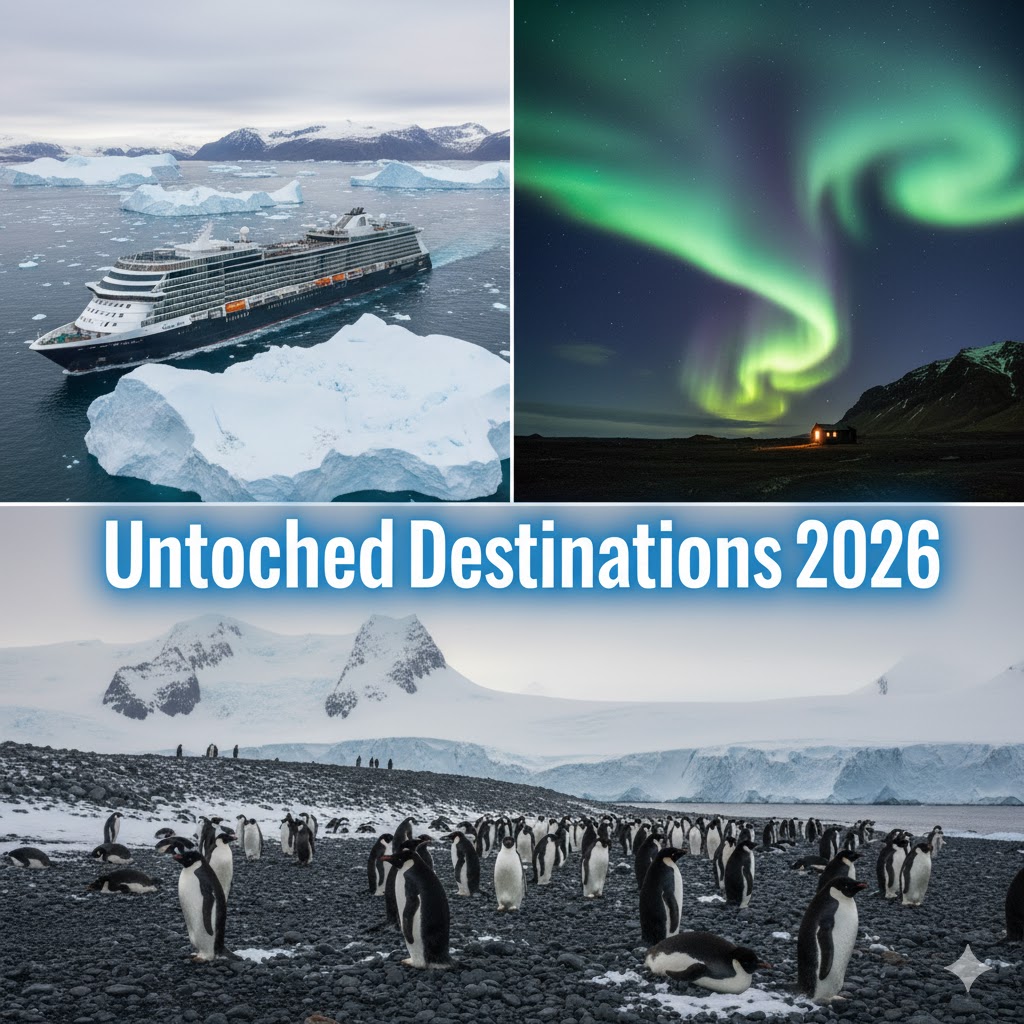
Arctic Cruises 2026 — Greenland & Svalbard Expeditions
The Arctic Circle has become the crown jewel of untouched destinations 2026.
Greenland’s ice fjords, Svalbard’s polar bears, and Norway’s glass igloo lodges are redefining luxury adventure. New hybrid-powered ships like the MS Fridtjof Nansen offer sustainability without sacrificing comfort — proof that exploration and eco-consciousness can co-exist.
Traveler Tip:
Visit between June and August for the midnight sun and Arctic wildlife sightings. Choose smaller expedition lines that work with indigenous communities to reduce environmental impact.
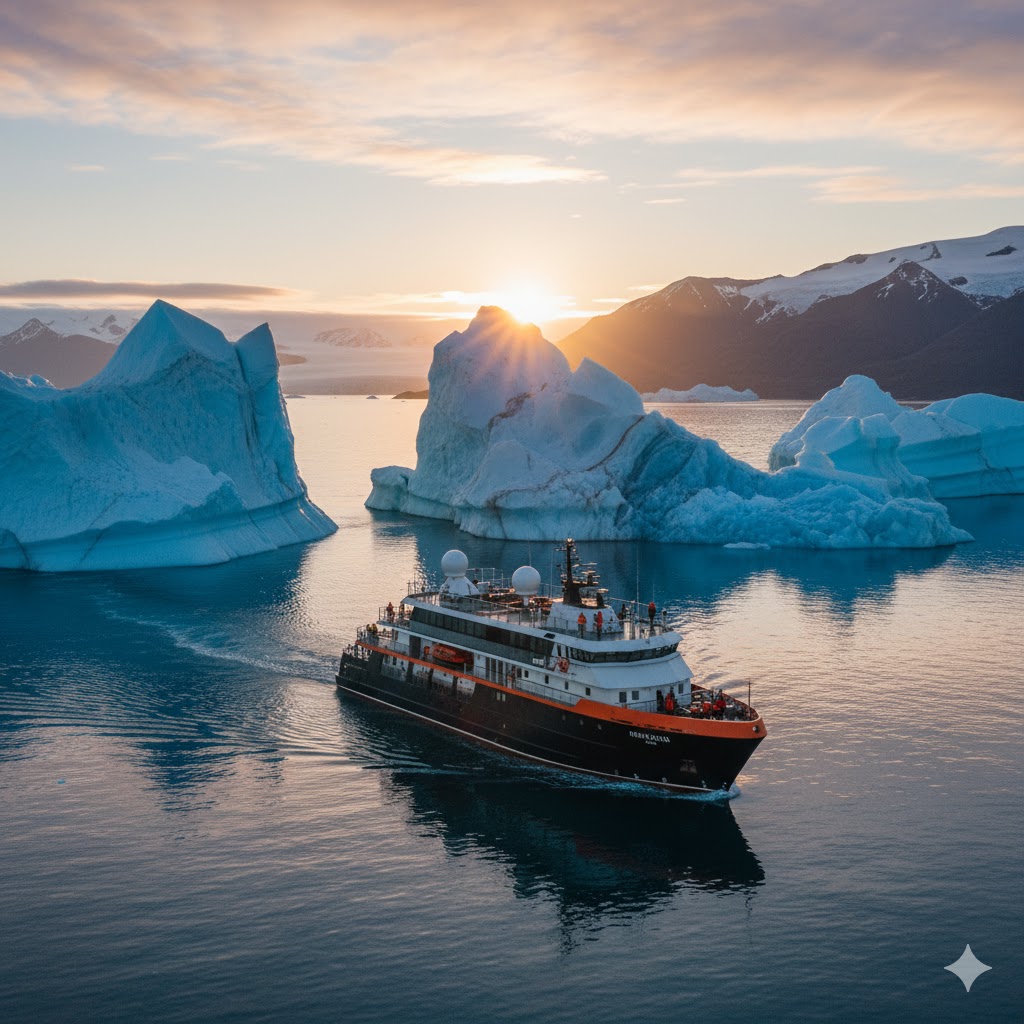
Iceland’s Frozen Wonders — The Northern Lights Reawaken
Few experiences match the first glimpse of the Aurora Borealis dancing above Iceland’s lava plains. After a tourism slowdown, Iceland is again welcoming mindful travelers seeking serenity beyond Reykjavik’s crowds.
The 2026 trend is shifting toward private aurora domes, glacier hiking, and geothermal spa retreats in the country’s north.
Local guide Edda Björk says, “People don’t come for fireworks anymore; they come to stand under the sky and feel alive.”
Traveler Tip:
Plan between September and March for peak aurora season. Combine the Blue Lagoon’s new sustainability-focused spa and Akureyri’s untouched trails for a balanced itinerary.
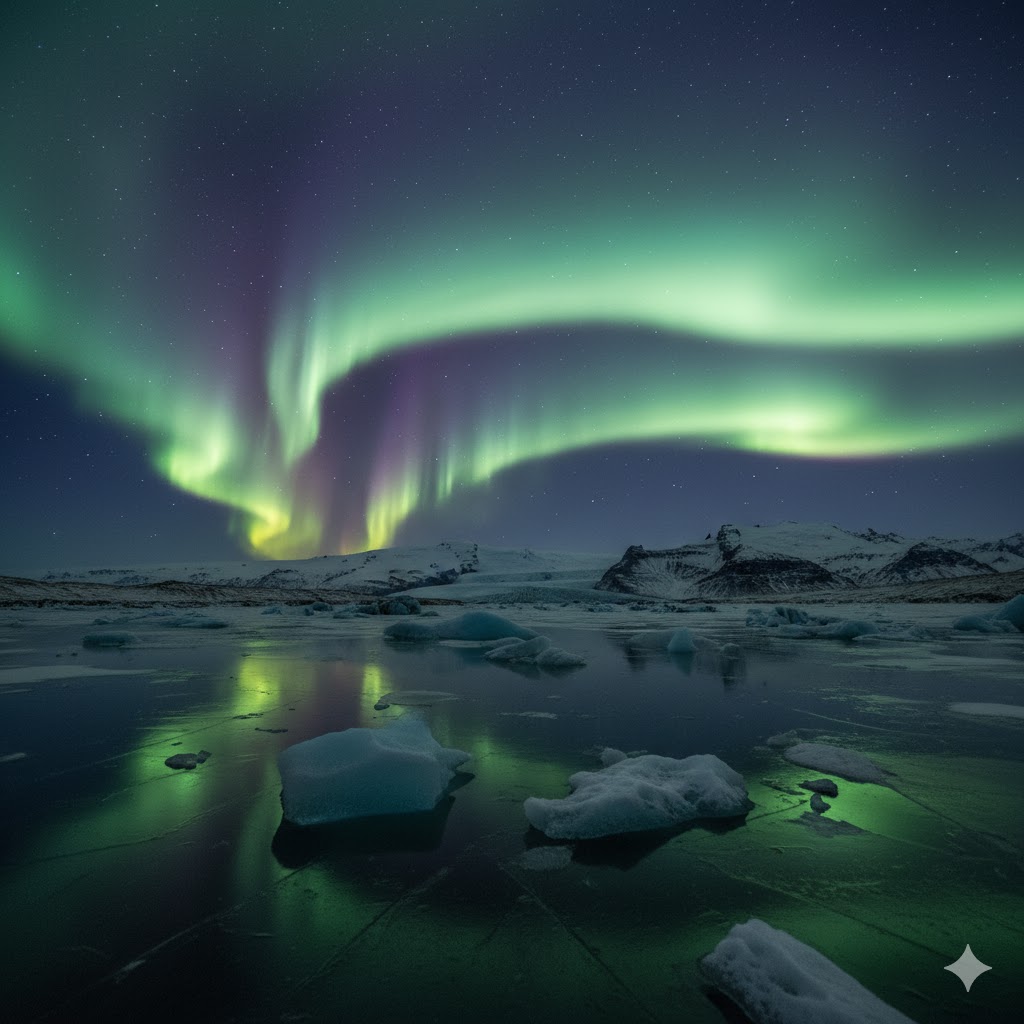
Antarctica’s Sustainable Expedition Boom
Far to the south, Antarctica remains the purest untouched destination on Earth. Once accessible only to researchers, now eco-certified cruises and small group journeys allow travelers to walk on the white continent — without harming it.
Every visitor follows the Antarctic Treaty’s “leave no trace” rule, monitored by guides and conservationists.
Luxury companies like Quark Expeditions and Ponant are introducing hybrid electric vessels and carbon offset systems, making 2026 the year when luxury meets low impact.
Traveler Tip:
Book early-season (November–January) to catch penguin hatchings. Travel with companies that support the Association of Arctic Expedition Cruise Operators (AECO) standards.
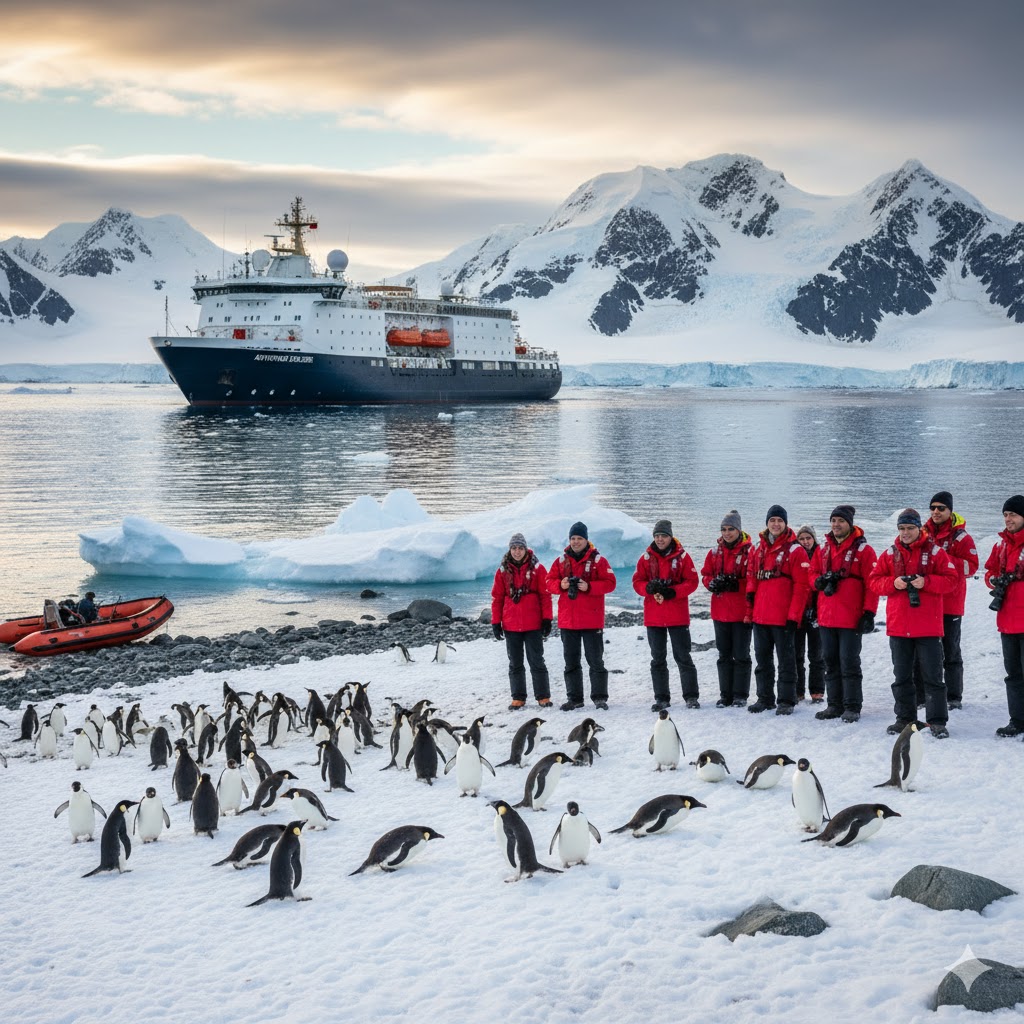
Why Polar Regions Matter in 2026’s Travel Revival
As the rest of the world chases crowds, the poles offer a rare gift: emptiness filled with meaning. For 2026, polar travel isn’t about ticking off a bucket list — it’s about rediscovering the planet’s emotional power.
“The poles remind us that travel is a privilege,” says Mara Jensen, sustainability director at The Polar Travel Company. “Every iceberg you see, every penguin you meet, should make you care more deeply about the Earth you came from.”
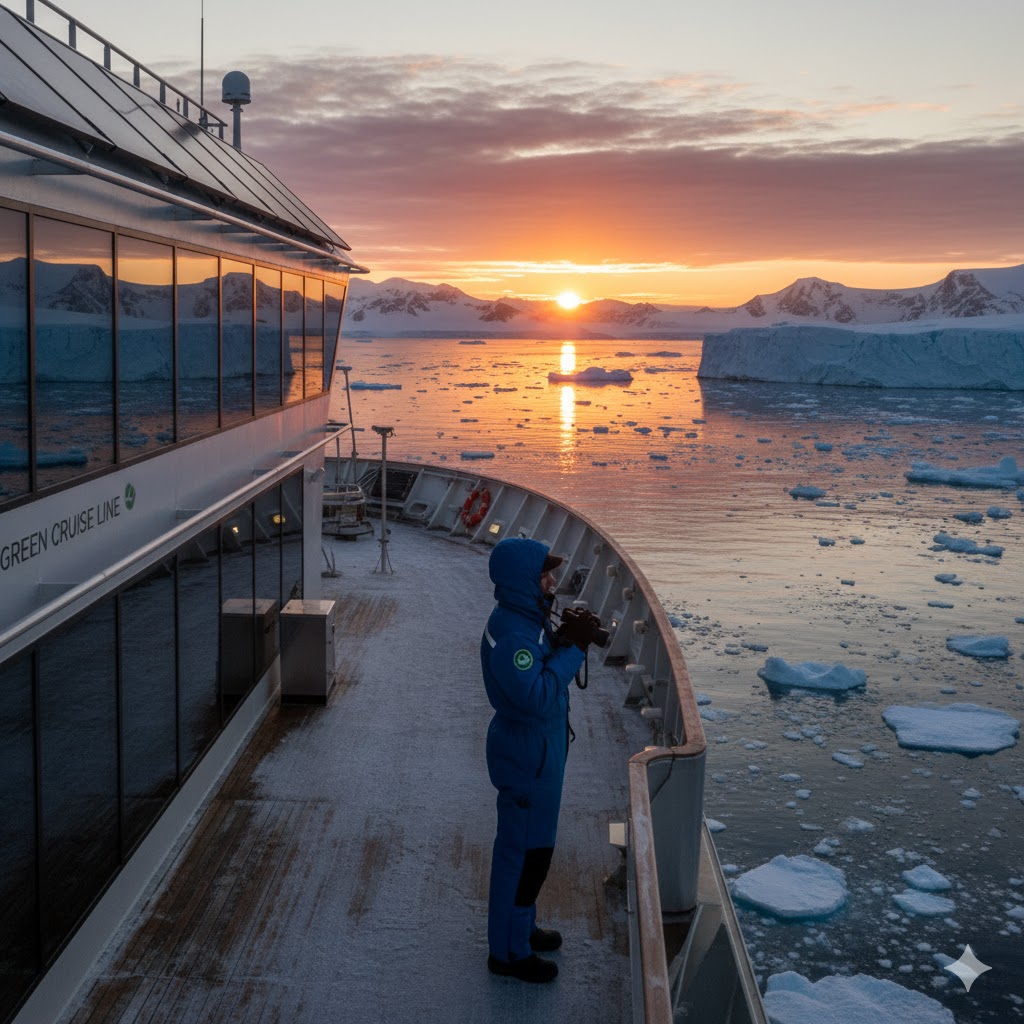
Read More
- Read next: Best Travel Destinations Reopening in 2025–2026
- Learn more about responsible polar trips at thepolartravelcompany.com and heritage-expeditions.com
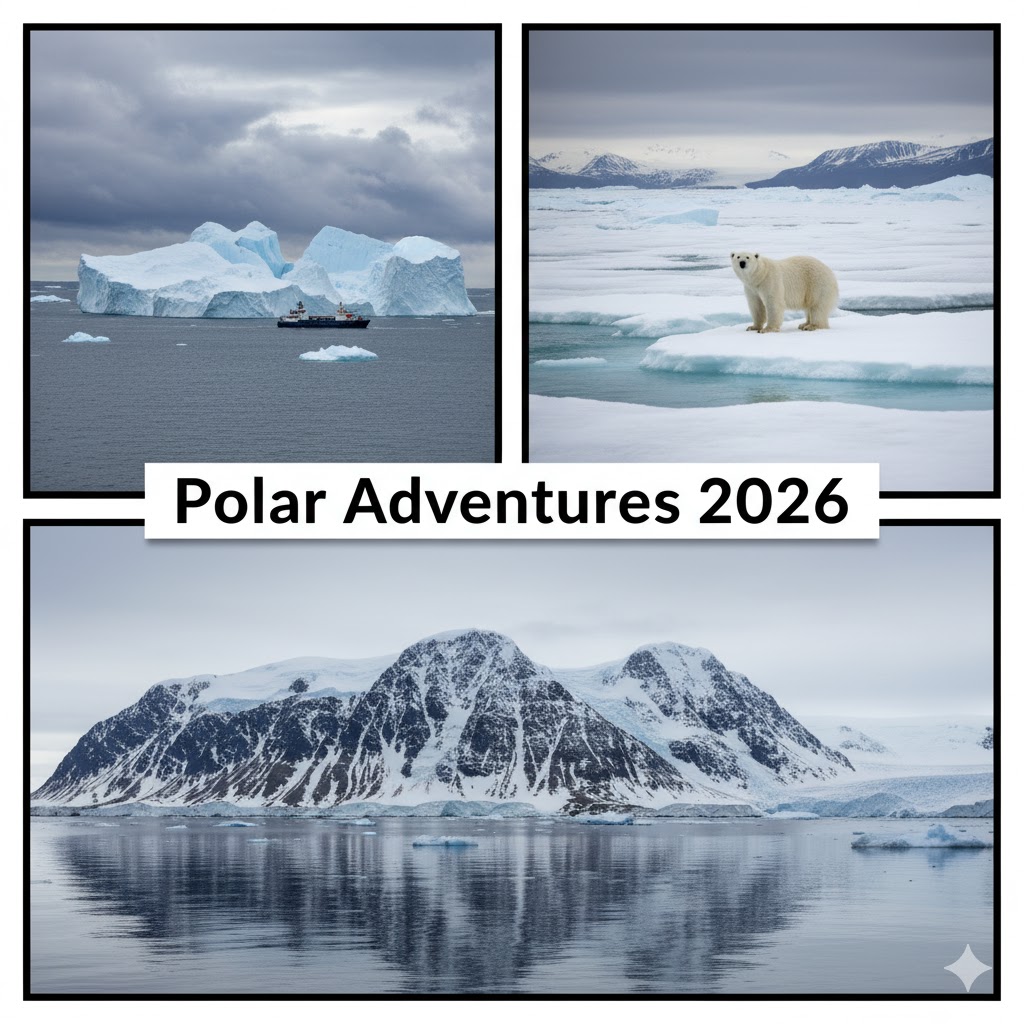

The Ocean Worlds: Remote Islands Reimagined (2026 Edition)
From Coral Kingdoms to Secret Shores — The Rebirth of Island Travel
After years of over-tourism, 2026 marks a turning point. Travelers are trading mega-resorts for remote islands that prioritize conservation, authenticity, and local connection.
These are not your typical “tropical getaways.”
They are eco-sanctuaries, coral research hubs, and sacred lands where travel feels like both a privilege and a purpose.
“The islands that protect their environment will be the ones that survive tourism’s next era,” says Marine biologist Leilani Ramos, who works in Palau’s conservation program.
From Indonesia’s hidden reefs to Costa Rica’s jungle-fringed coasts, these ocean worlds invite travelers to rediscover serenity, slow exploration, and soul-deep wonder.
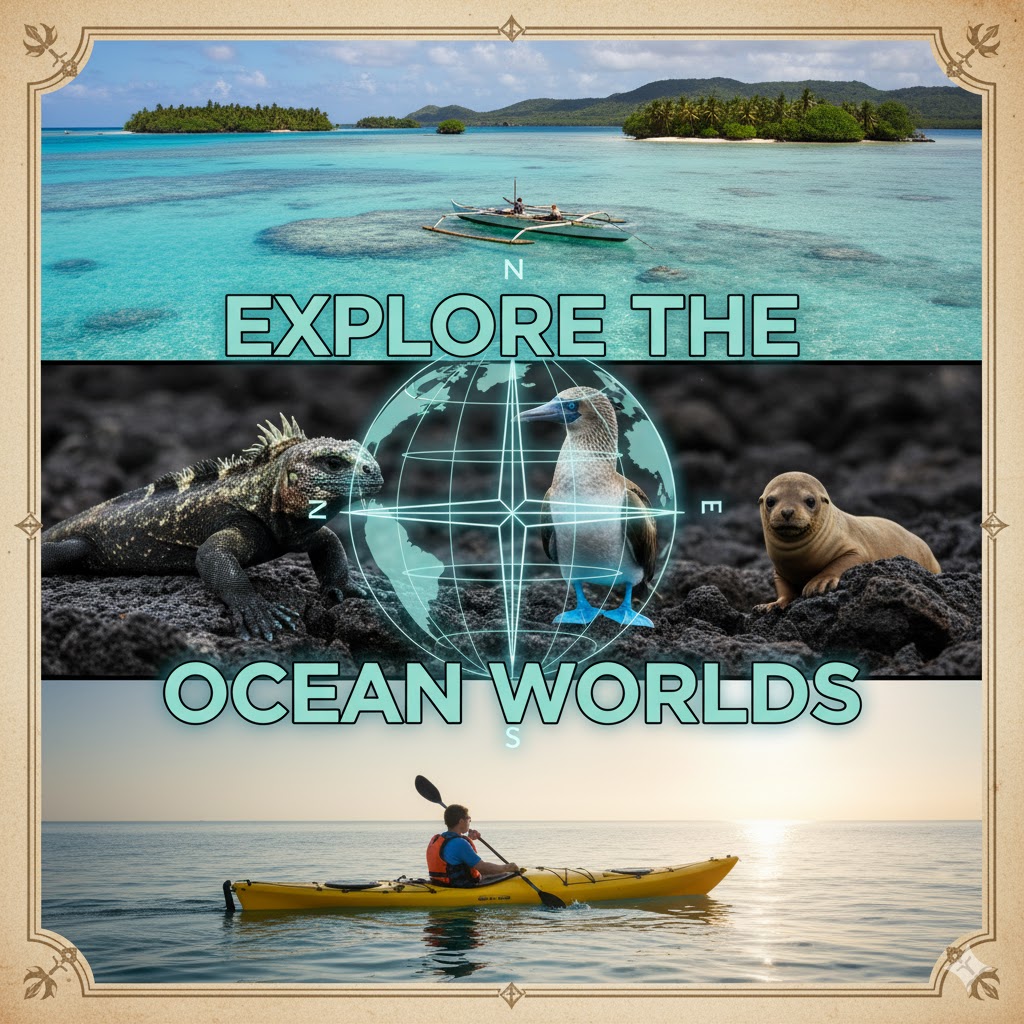
1. Raja Ampat, Indonesia — The Crown Jewel of Biodiversity
The Raja Ampat Archipelago is a living cathedral beneath the sea.
With over 600 coral species and 1,700 kinds of fish, it’s home to 75% of the world’s coral biodiversity.
In 2026, Indonesia’s new “Blue Halo” marine zones limit visitor numbers and prioritize community-led dive operations — protecting reefs while empowering local families.
“We only host what our reef can handle,” says Ayu Lestari, dive instructor at Sorido Bay Eco Resort. “That’s why Raja Ampat still feels alive.”
Traveler Tip:
Choose eco-certified liveaboards that partner with local rangers. Don’t chase rare fish — let the reef show itself to you.
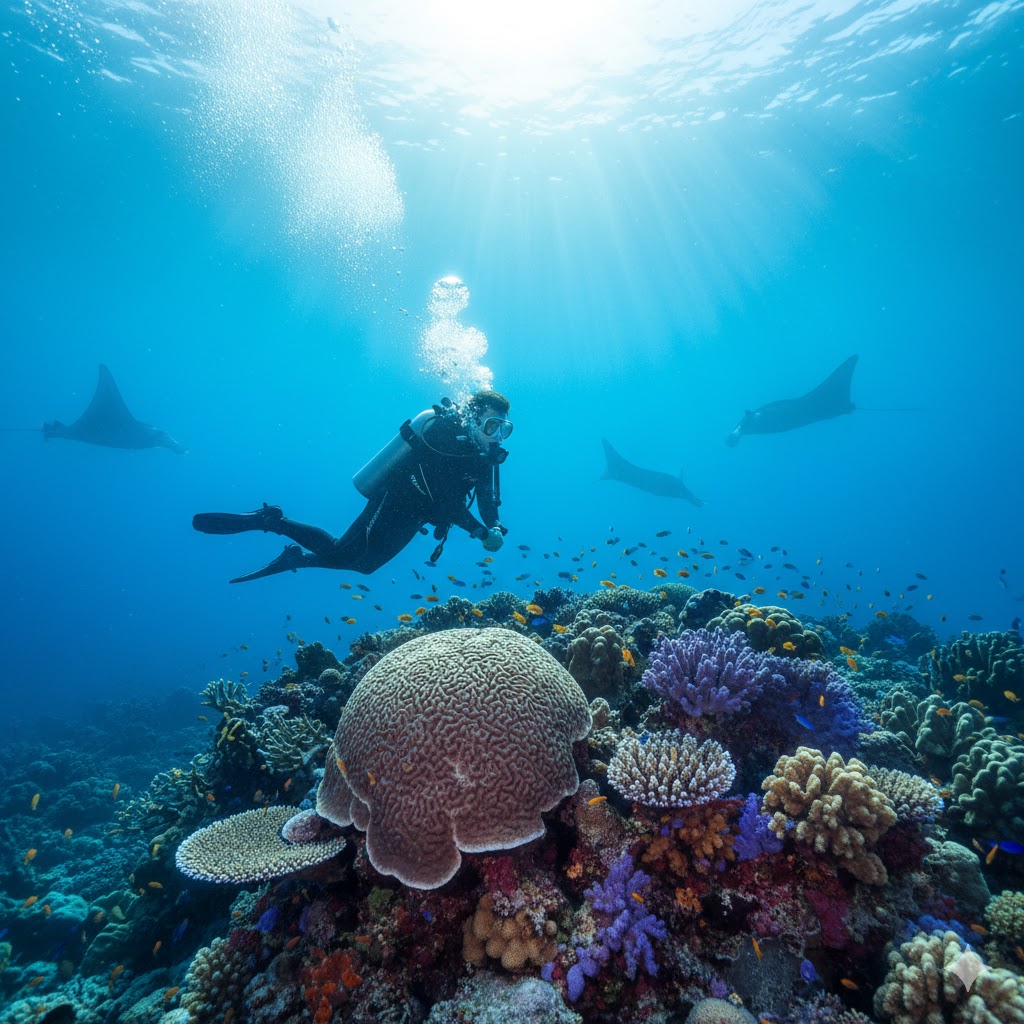
2. Palau — The Blueprint for Ocean Conservation
Tiny but mighty, Palau remains the world’s most innovative eco-tourism nation. Its “Palau Pledge,” signed by every visitor upon arrival, promises respect for its land and sea.
Now in 2026, Palau has introduced AI-based reef monitoring and a no-sunscreen chemical zone, making it the first digital conservation nation.
“Our future depends on respect,” says Minister Elina Nakamura, head of Palau’s tourism board. “You don’t just visit Palau — you help protect it.”
Traveler Tip:
Explore Rock Islands by kayak. Avoid plastic, use reef-safe sunscreen, and take the Palau Pledge seriously — locals appreciate it deeply.
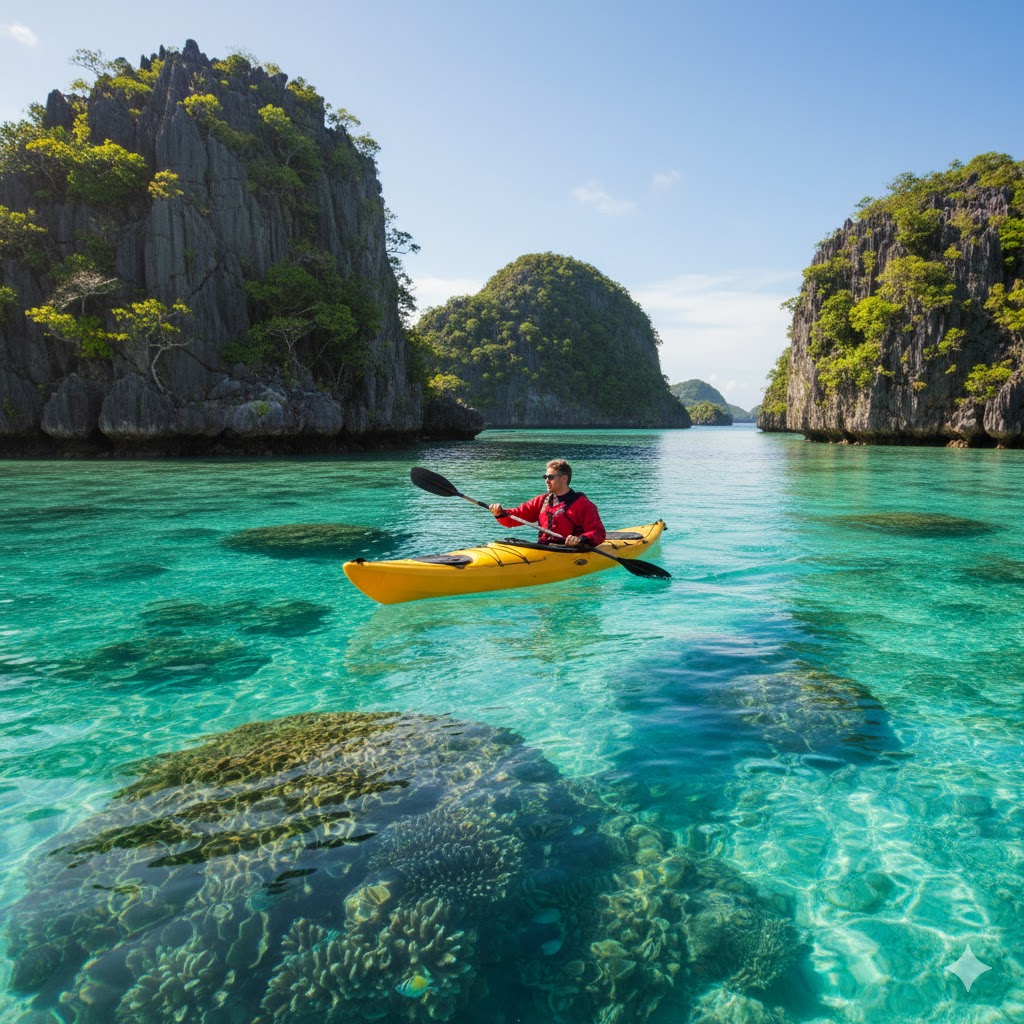
3. The Galápagos Islands, Ecuador — The Living Laboratory
The Galápagos have long defined responsible tourism, but in 2026 they’re reintroducing controlled micro-expeditions — smaller ships, slower travel, and more meaningful interaction.
“We’re rewriting the rules of adventure,” says guide Miguel Torres, who’s been leading Galápagos tours for 20 years. “Less speed, more science.”
Expect hybrid-electric catamarans, digital reef mapping tours, and renewed emphasis on species observation led by certified naturalists.
Traveler Tip:
Visit in April or November for fewer crowds. Respect wildlife distance laws — even a selfie can stress endemic species.

4. Costa Rica — The Comeback of Eco-Luxury
Costa Rica eco travel 2025 is trending again — not for its beaches, but for its commitment to balance.
Post-2024, the country launched the “Pura Vida Rewilding Initiative”, linking national parks with reforestation corridors and eco-lodges that contribute to conservation.
From the Osa Peninsula’s jungle retreats to Nicoya’s longevity villages, Costa Rica leads a movement toward “luxury with purpose.”
“You don’t visit Costa Rica,” says local guide Daniela Solís. “You become part of it.”
Traveler Tip:
Book carbon-neutral stays near Corcovado National Park. Learn from indigenous Bribri guides who offer forest medicine walks.

5. Canary Islands, Spain — Europe’s New Wellness Frontier
While mainland Spain dominates headlines, the Canary Islands are quietly redefining wellness and digital-nomad travel for 2026.
Lanzarote’s lava spas, Tenerife’s yoga retreats, and La Palma’s new stargazing lodges attract those seeking balance rather than buzz.
Spain reopening 2025 campaigns have focused heavily on the islands’ natural healing appeal.
“We’ve shifted from mass tourism to mindful living,” says Marcos Díaz, owner of a wellness lodge in Gran Canaria. “People come here to heal — not to hurry.”
Traveler Tip:
Combine remote work with rest. Most wellness lodges now offer coworking decks overlooking volcanic landscapes.

Why These Islands Matter
Each of these destinations represents a return to balance — between nature and comfort, economy and ecology, traveler and host.
Remote islands travel 2026 isn’t just a trend. It’s a philosophy:
Slow down. Leave lighter footprints. And see beauty not just as a backdrop, but as a shared responsibility.
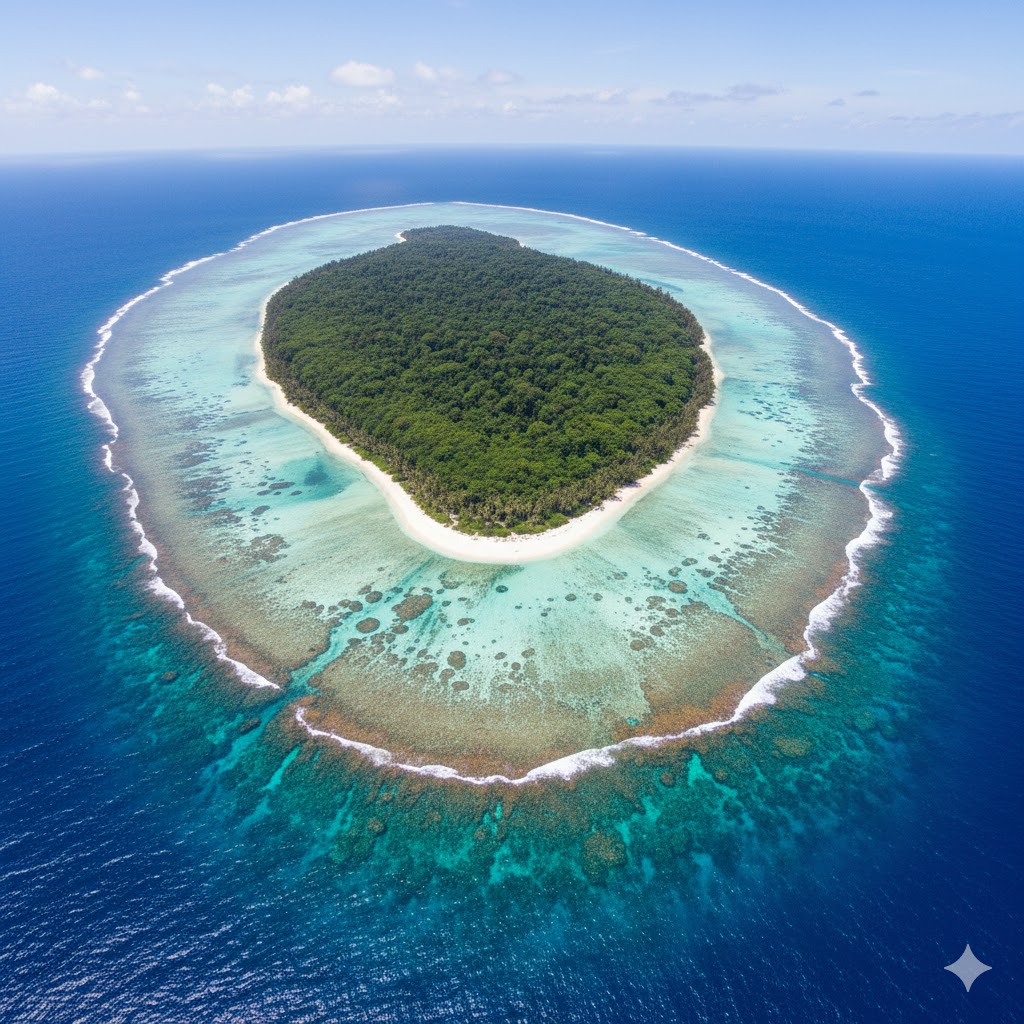
Read More / Sources:
- Read more: 7 Secret Beaches of Mantigue Island Travel Guide to Paradise
- Sources:
- blacktomato.com — for remote island conservation trips
- palaupledge.com — learn about sustainable visitor practices
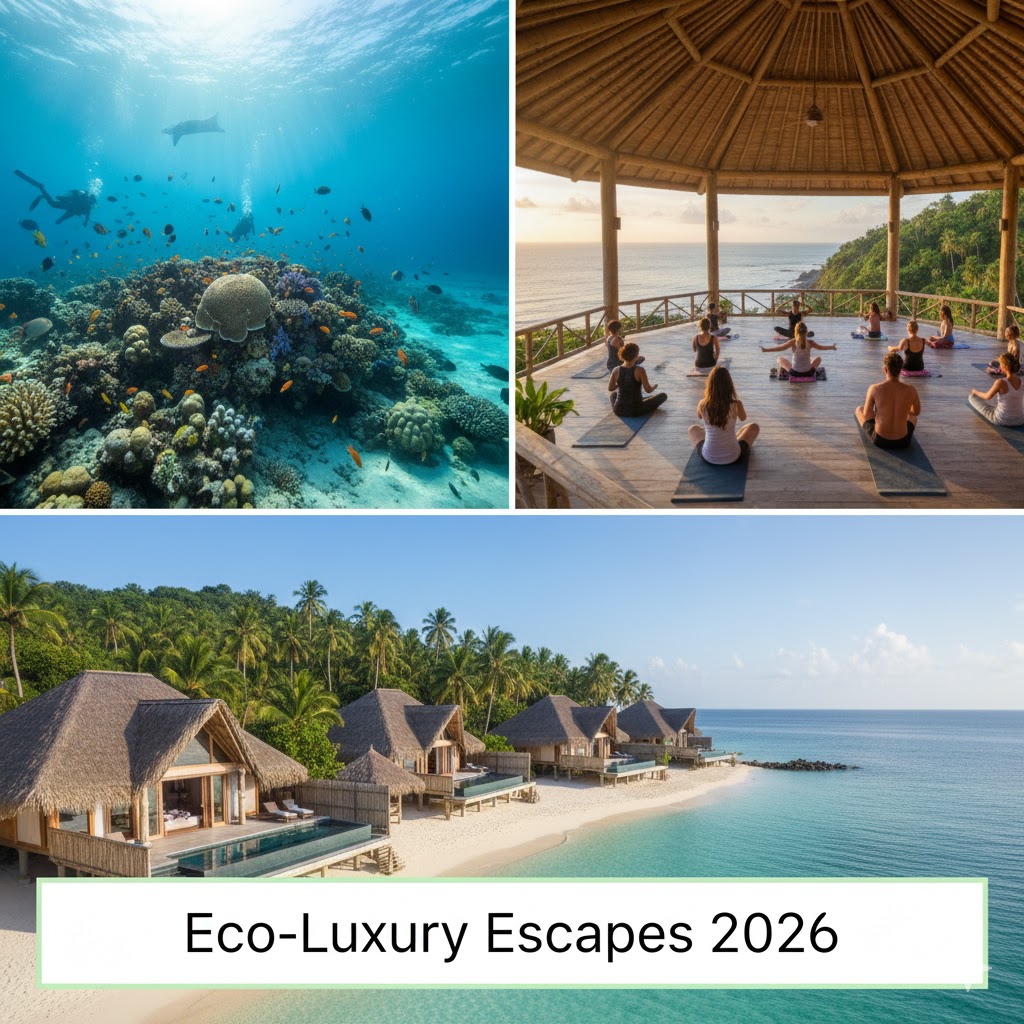
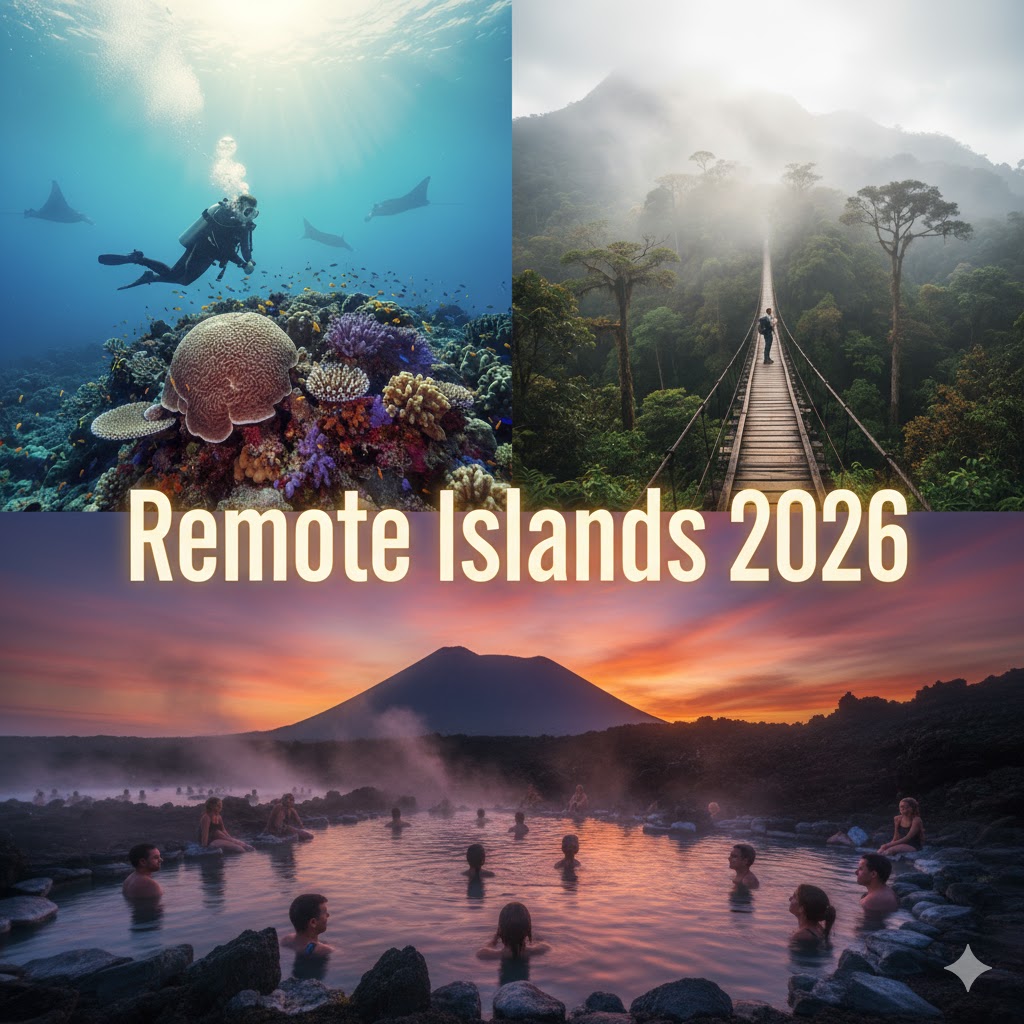
Hidden Highlands & Sacred Peaks: From the Himalayas to the Alps
The Return to the Peaks: Why Mountain Travel Is Reborn
After the global rush to beaches and cities post-pandemic, 2026 is bringing travelers back to altitude.
From the Indian Himalayas to the Swiss Alps, explorers are seeking sacred landscapes that offer both physical challenge and inner renewal.
“Mountains demand humility,” says Tsering Dorje, a Ladakh trekking guide. “They remind you that travel isn’t just movement — it’s transformation.”
In this new era, mountain tourism blends eco-luxury, spiritual wellness, and slow adventure, guided by locals who’ve lived at the edge of the clouds for centuries.

1. India — From the Himalayas to Goa: Reawakening the Spirit of Exploration
India travel reopening 2025 has reignited one of the world’s richest cultural landscapes.
In 2026, travelers are rediscovering two extremes — the Himalayan spiritual circuits of Himachal and Ladakh, and the coastal calm of Goa and Kerala.
- Himalayas travel 2026: Treks to monasteries in Spiti and Zanskar are now managed under “Leave No Trace India,” reducing waste on high-altitude routes.
- Goa tourism 2026: The new “Green Coast Trail” connects yoga retreats, spice plantations, and restored Portuguese villages via e-bikes.
“Travelers don’t want five-star — they want five senses,” says Anjali Menon, wellness resort founder in Kerala.
Traveler Tip:
Visit between May and September for clear Himalayan skies, or November–February for Goa’s cultural season.

2. Kyrgyzstan & Georgia — The New Silk Road Adventure
Central Asia and the Caucasus are emerging as 2026’s most exciting frontier adventure zones.
Kyrgyzstan offers alpine lakes, nomadic culture, and horseback expeditions across the Tian Shan Mountains.
Meanwhile, Georgia’s Svaneti region blends medieval towers, organic wine routes, and wild backcountry trails.
“This is the Silk Road reimagined,” says guide Temirbek Uulu from Karakol. “No crowds. Just silence, stars, and endless valleys.”
Both countries are part of the new “Eco-Adventure 2026 Corridor”, promoting low-impact travel across the Caucasus range.
Traveler Tip:
Try community-based tourism homes in Kyrgyzstan — they support women entrepreneurs.
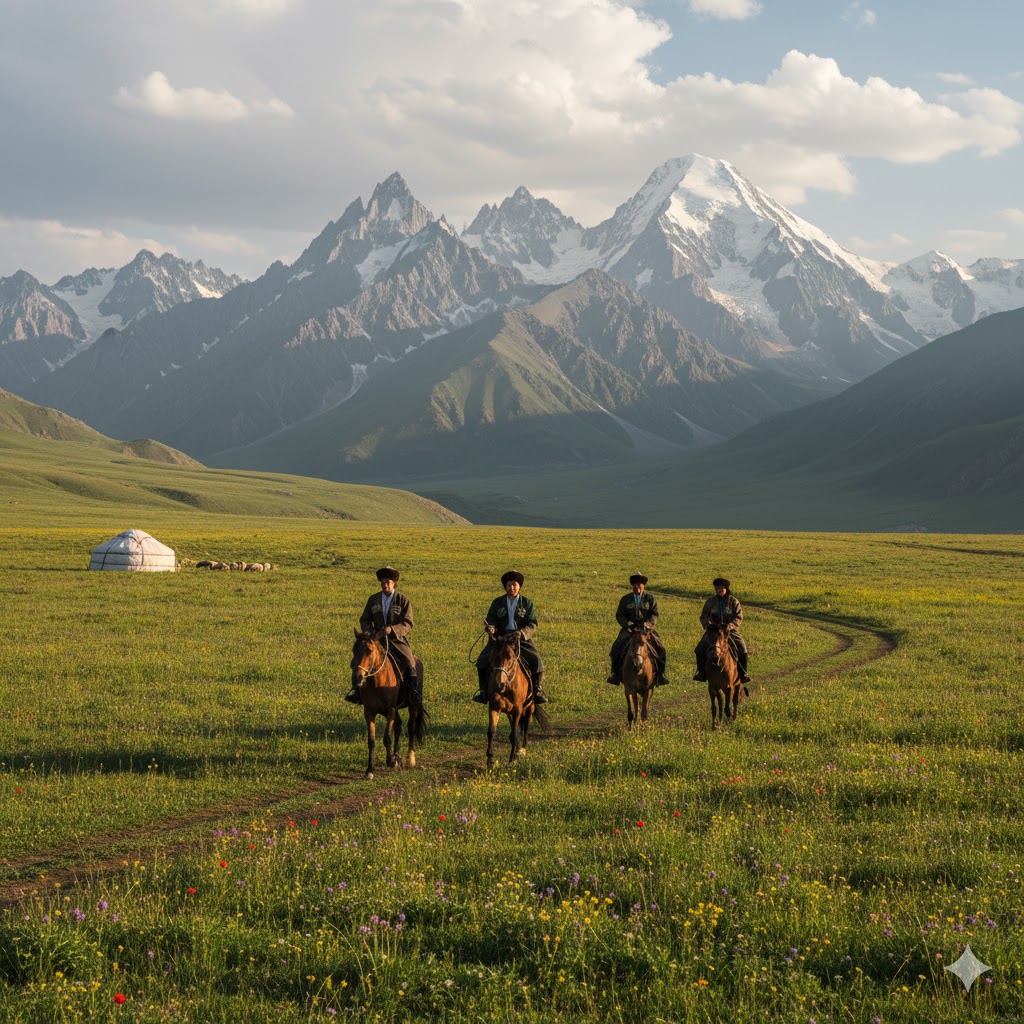
3. Switzerland — Reinventing the Alps for the Future
The Swiss Alps 2026 ski season is shaping up to be Europe’s most sustainable yet.
Resorts like Zermatt, Verbier, and Davos are investing in carbon-neutral ski lifts, glacier protection tunnels, and summer alpine trails to adapt to shorter winters.
“We’ve moved from consumption to preservation,” says Claudine Baumann, sustainability director at Zermatt Tourism. “Our glaciers are our identity — we protect them like family.”
In summer, Swiss chalets now double as wellness lodges offering thermal springs, hiking, and sound therapy — appealing to travelers who want altitude without adrenaline.
Traveler Tip:
Buy regional rail passes — Switzerland’s eco-trains now connect 80% of ski resorts directly from Zurich or Geneva.
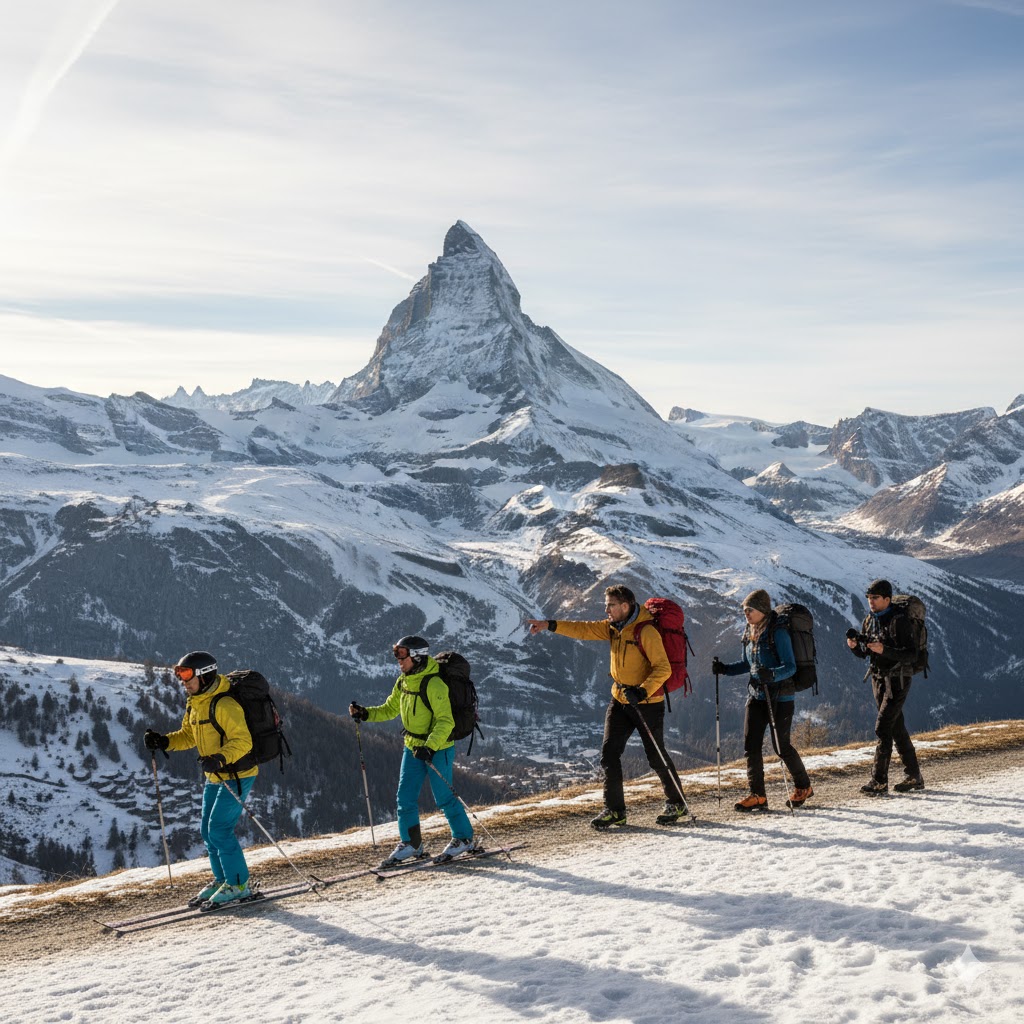
4. Northern Lights Expeditions — Finland & Norway
Aurora tourism is making a dazzling return in Northern Europe, especially as new Finland winter travel 2026 packages combine wellness cabins, reindeer safaris, and digital detox zones.
Norway’s Alta and Tromsø, meanwhile, are becoming epicenters of science-meets-spirituality travel, where visitors learn the physics and folklore of the aurora under expert guidance.
“The Northern Lights are not just a spectacle — they’re a story,” explains Finnish astronomer Aino Lehtinen. “And in 2026, that story includes sustainability.”
Traveler Tip:
Visit from September to March. Choose locally owned lodges that use thermal insulation and serve Sami-produced cuisine.
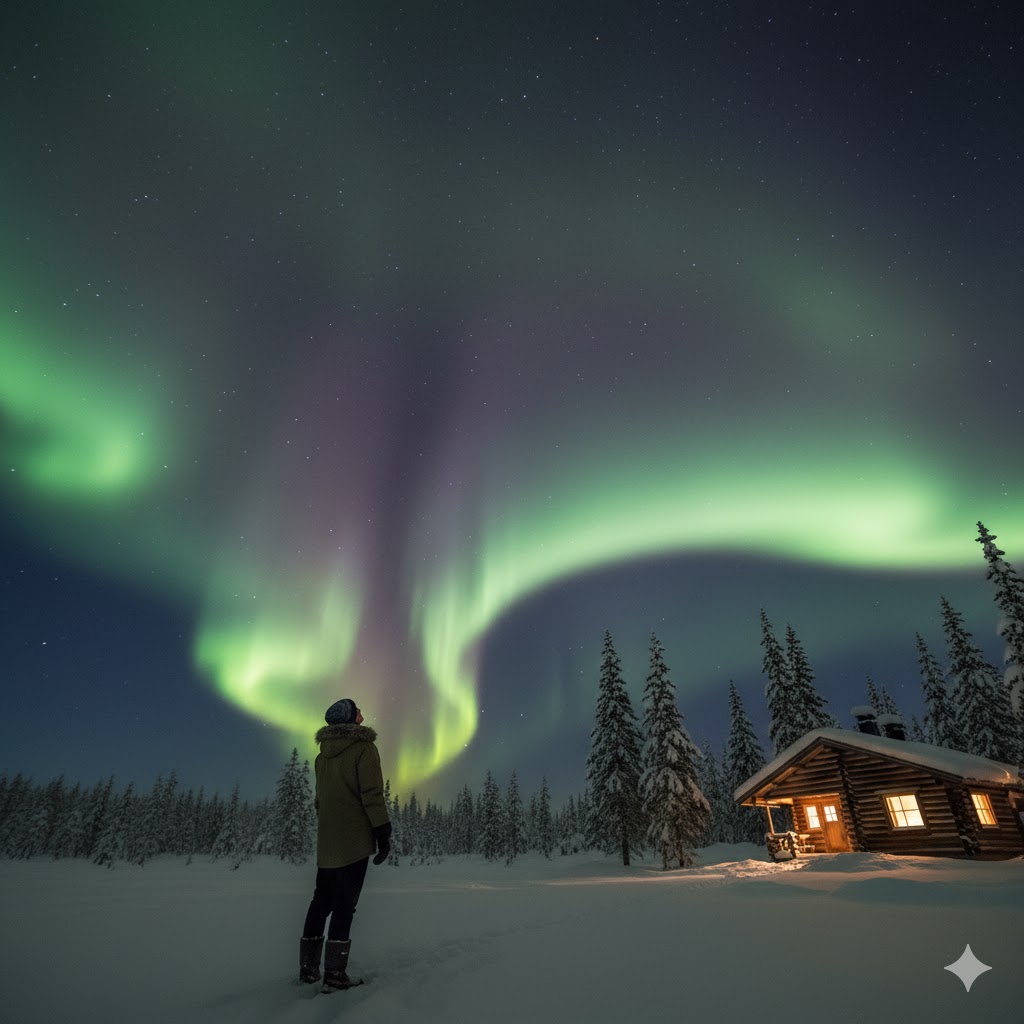
Why the World Needs Its Highlands Again
The mountains remind us that true travel isn’t about speed — it’s about stillness.
These untouched destinations 2026 are more than scenic spots; they are classrooms of humility, resilience, and awe.

Sources / Read More:
- Read next: 10 Amazing Floating Vegetation Island Wonders Locals Walk On
- External references:
- myswitzerland.com — for alpine eco-initiatives
- incredibleindia.org — official site for cultural and eco-trekking routes
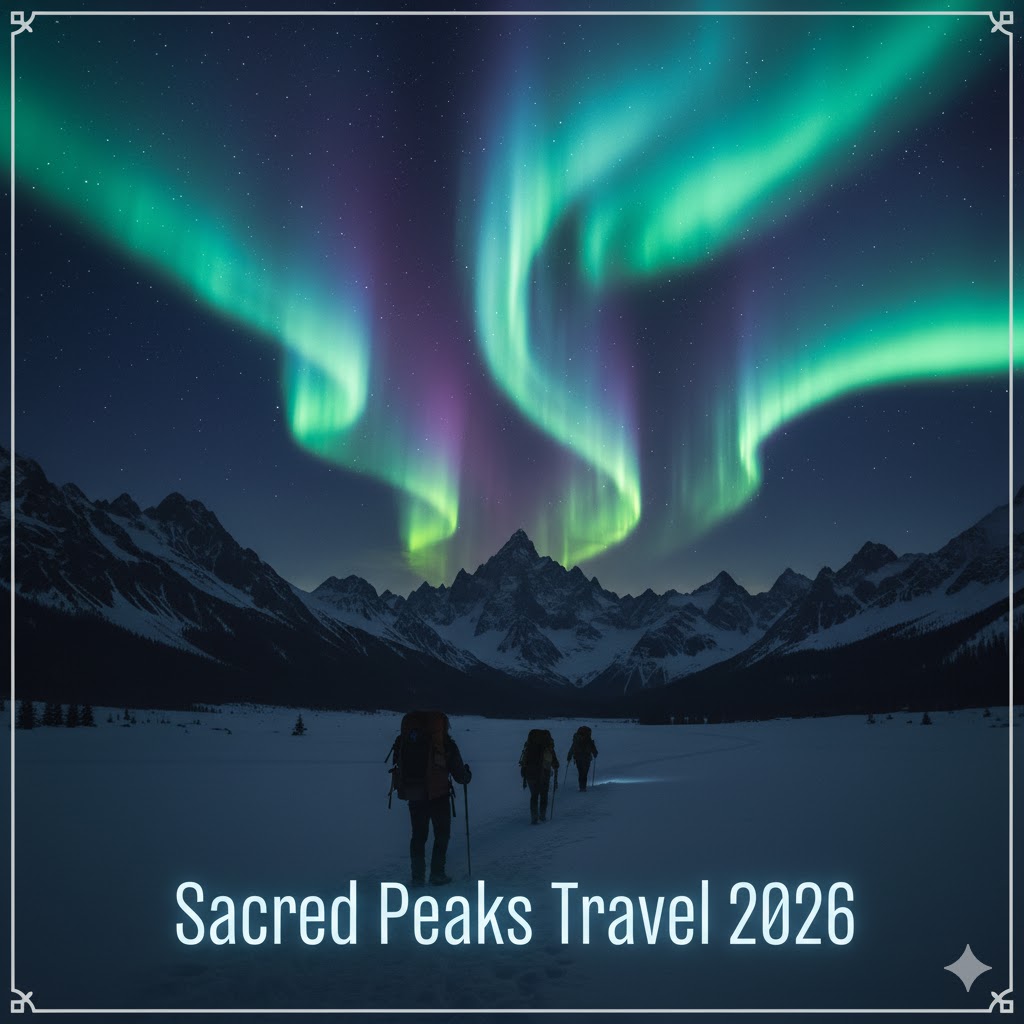
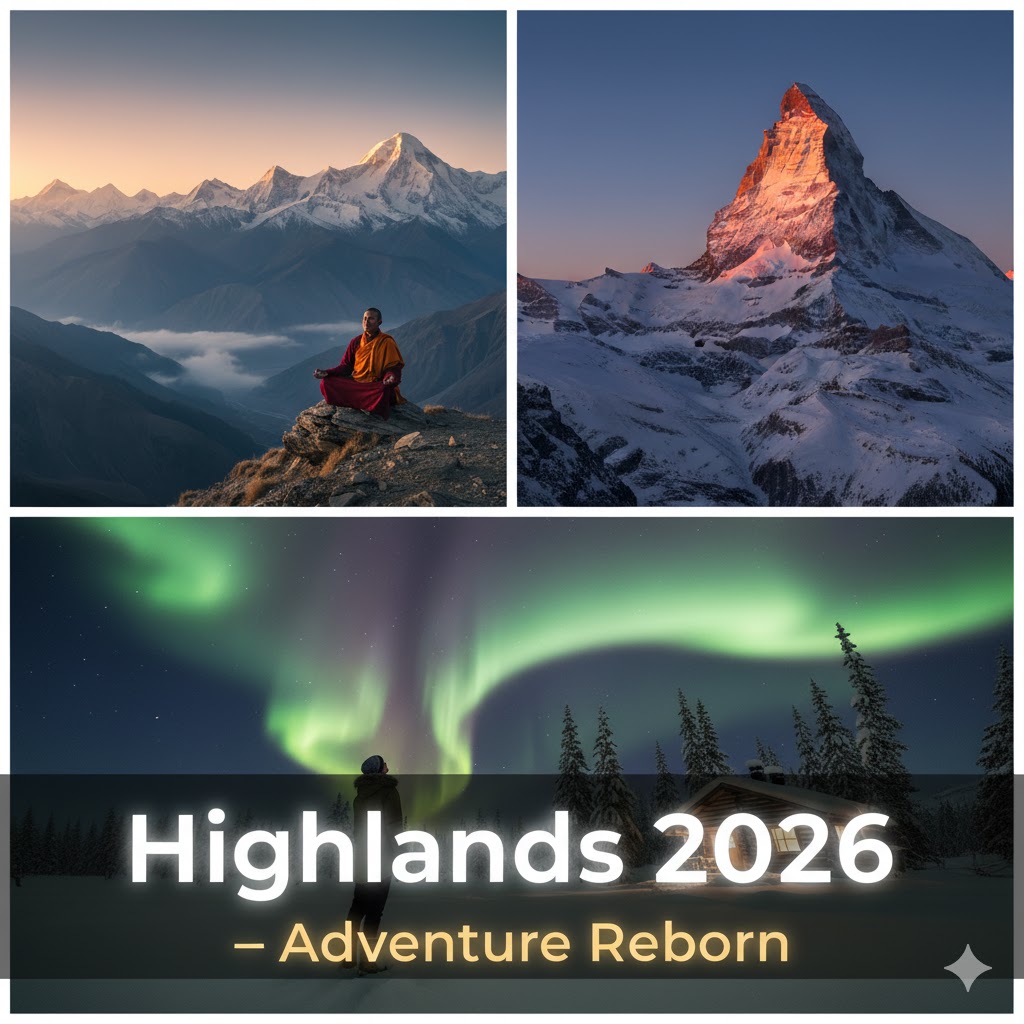
Deserts, Dynasties & Dreamscapes: The Middle East to East Asia Revival
The Middle East Renaissance — Where Heritage Meets Sustainability
The Middle East is rewriting its tourism story — from oil-rich exclusivity to eco-luxury inclusivity.
In 2026, countries like Oman, Jordan, and Saudi Arabia are attracting travelers seeking ancient culture, starry deserts, and sustainable modernity.
“Our desert is no longer empty — it’s alive with design and dialogue,” says Amal Al Riyami, an Omani desert camp curator. “We’re blending Bedouin wisdom with green tech.”

1. Oman — The Desert Kingdom of Silence and Stars
Oman desert tourism 2025 is setting a new benchmark for regenerative travel.
The Wahiba Sands are now home to eco-camps powered entirely by solar energy, featuring water-recycling domes and guided stargazing with astronomers from Muscat University.
Travelers can embark on 4×4 dune safaris, visit Nizwa Fort, or camp under the Al Hajar Mountains while sipping cardamom coffee by candlelight.
“Visitors come for the dunes but stay for the humility,” says Saeed Al Hinai, a Bedouin guide.
Traveler Tip:
Visit between October and April for mild weather; avoid midsummer heat.
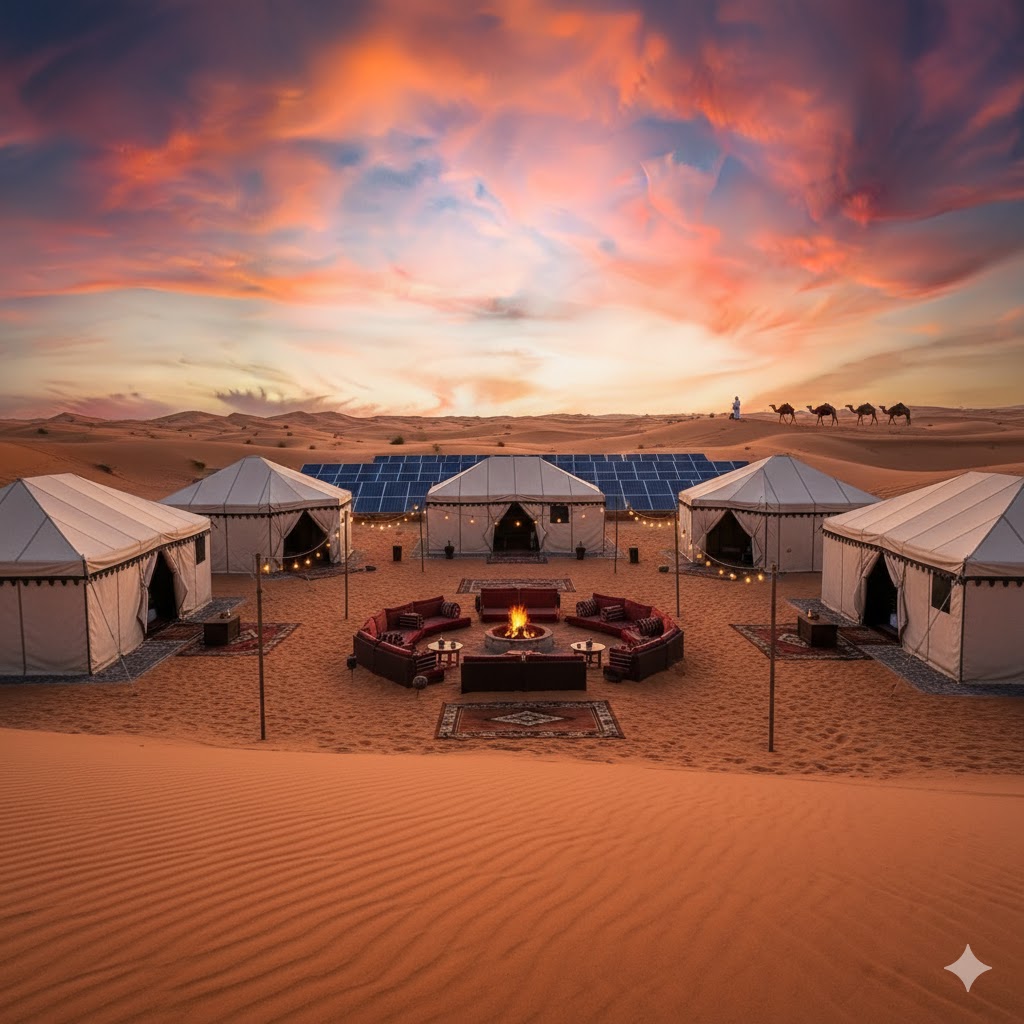
2. Jordan — Beyond Petra: Red Sands and Rejuvenation
Jordan Petra travel 2026 headlines the revival of Middle Eastern adventure tourism.
Petra’s rose-red temples remain iconic, but 2026 travelers are heading deeper — into Wadi Rum, where Martian landscapes meet wellness glamping.
The Jordan Tourism Board has introduced “Petra by Moonlight”, a night tour featuring traditional Bedouin music and storytelling under the stars.
“It’s not about taking pictures — it’s about being part of a 2,000-year-old story,” says Salem Haddad, a local tour guide from Wadi Musa.
Traveler Tip:
Combine Petra and the Dead Sea with a detour to Aqaba for coral reef snorkeling — now under eco-protection.

3. Saudi Arabia — The Futuristic Heritage Frontier
AlUla is redefining heritage tourism with the “Journey Through Time” project, merging archaeology with luxury.
Desert lodges are sculpted into cliffs, while NEOM’s The Line City aims to be carbon-free and AI-integrated.
“Saudi tourism is no longer about exclusivity — it’s about innovation,” says Layla Al Saif, cultural consultant at the Royal Commission for AlUla.
Traveler Tip:
Foreign travelers can now get e-visas instantly; plan early for major festivals like Winter at Tantora.

East Asia’s Grand Reopening — China and Beyond
After a long pause, China tourism reopening 2025 is reigniting travel to Beijing, Shanghai, and rural heritage towns.
The country’s new tourism model promotes “slow culture and clean air” — encouraging travelers to stay longer and explore local life beyond mega-cities.
4. China — Culture Reimagined for a New Era
Beijing and Shanghai travel 2026 will focus on heritage restoration and modern art.
Beijing’s hutongs (alleyways) are being converted into craft studios and tea gardens, while Shanghai’s Bund is welcoming a wave of floating restaurants and sky-view observatories.
The government’s “Green China 2026” policy is also opening up Yunnan, Guilin, and Zhangjiajie, known for their misty karst mountains and ancient villages.
“Post-2025 travel in China isn’t about scale anymore — it’s about story,” says Liang Chen, founder of Heritage Routes Beijing.
Traveler Tip:
Avoid national holidays to skip crowds; explore Yunnan’s rice terraces in March–April.

5. Costa Rica — Central America’s Green Comeback
While Asia reopens, Costa Rica eco travel 2025 continues to lead globally.
This small but mighty nation has pledged to become carbon neutral by 2050, and by 2026, most luxury lodges already operate off-grid.
Rainforest lodges like Lapa Rios and Nayara Springs are blending eco-therapy, wildlife conservation, and local employment programs.
“We don’t sell hotels — we sell hope,” says Maria Jiménez, owner of a family-run ecolodge in Osa Peninsula.
Traveler Tip:
Visit from December to May; support certified “Rainforest Alliance” tours.

The Spirit of Rediscovery
Whether it’s Oman’s dunes or China’s temples, the 2026 travel revival is more than reopening borders — it’s reopening meaning.
Travelers are not chasing Wi-Fi anymore; they’re chasing wisdom.

Must Read / Sources:
- Must See: La Monja Island Manila Bay: 5 Hidden Wonders to See
- External:


The Final Frontier: Polar Worlds, Hidden Islands & the Future of Ethical Exploration
Introduction — Where the Map Fades, the Mind Expands
As global travel expands again, a new kind of explorer is emerging — one who values preservation over possession, and meaning over miles.
From the icy silence of Antarctica to the coral-fringed atolls of the Pacific, 2026 represents the age of ethical exploration — travel that heals, not harms.
“Exploration is not about claiming new lands anymore — it’s about reclaiming our connection with the planet,” says Dr. Elise Norberg, a polar scientist working with the Sustainable Tourism Coalition (STC).
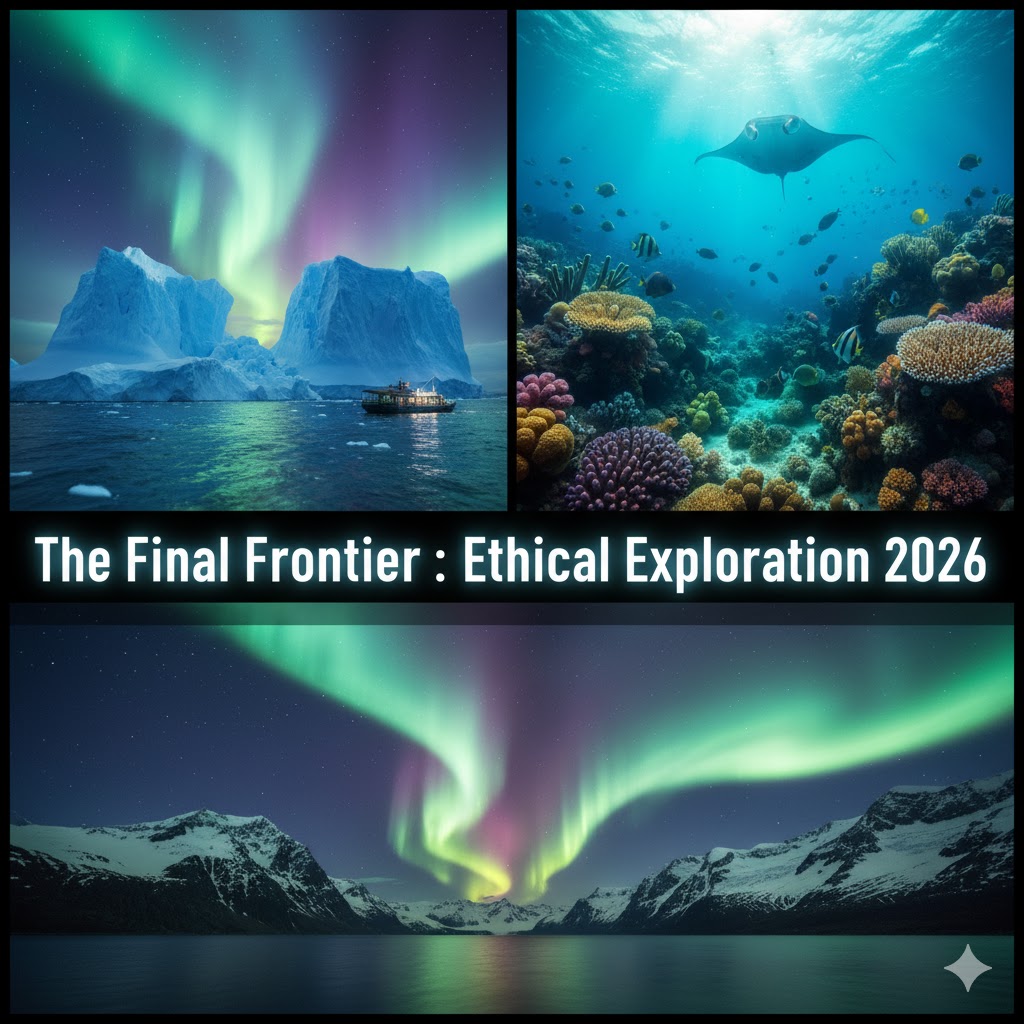
1. The Arctic Awakens — Greenland & Svalbard Go Green
Greenland Adventure Travel 2026
Greenland, the world’s largest island, is emerging as the new epicenter for climate-conscious adventure.
Kayaking between icebergs, hiking along fjords, and visiting Inuit fishing villages are redefining what responsible exploration means.
The Arctic Circle Trail — now upgraded with zero-impact shelters — offers an epic 160km trek through tundra, lakes, and ice fields.
“Visitors come for the ice, but stay for the stories,” says Aput Nuka, a local guide from Kangerlussuaq. “We don’t sell adventure — we share survival.”
Traveler Tip:
Visit from June to September. Pack biodegradable toiletries — waste removal is extremely limited.
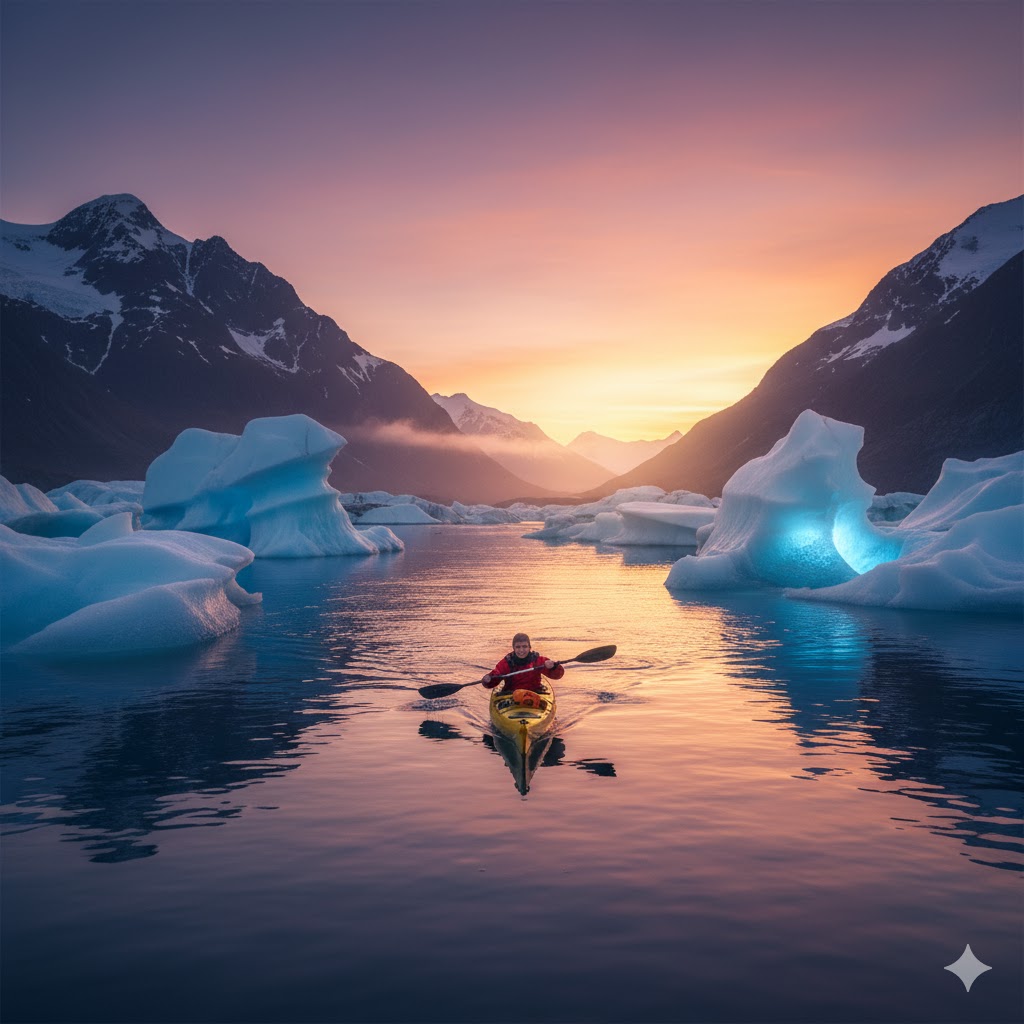
Svalbard — Norway’s Frozen Eden
Polar tourism 2026 in Svalbard emphasizes research-based travel.
Tour companies now partner with scientists to allow tourists to collect microplastic samples or assist in reindeer census counts.
This “citizen science” movement makes every visitor a temporary environmental guardian.
“We’re teaching travelers to leave the Arctic better than they found it,” explains Dr. Kari Lindholm, a marine biologist from Longyearbyen.
Traveler Tip:
Join eco-certified cruises that cap emissions at under 50g CO₂ per passenger-kilometer.
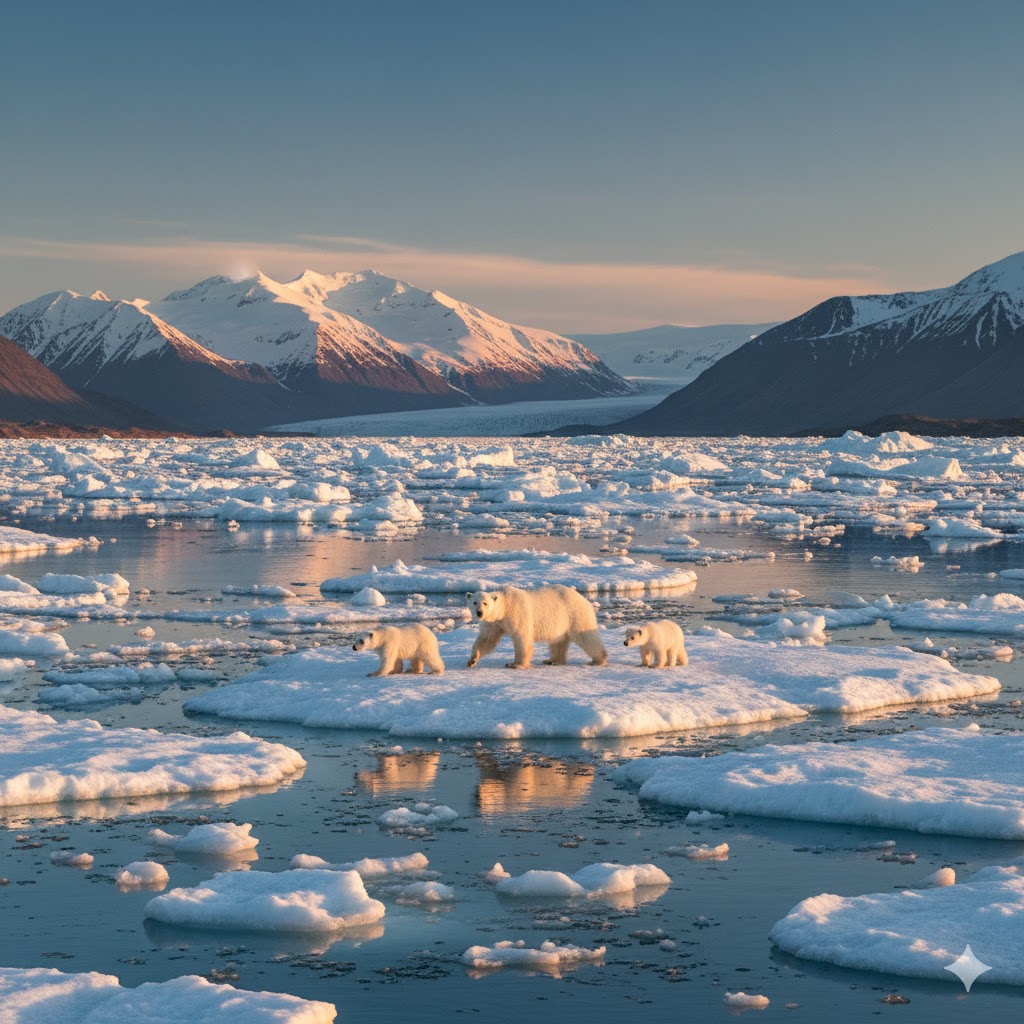
2. Antarctica — The Last Pure Wilderness
Sustainable Antarctica expeditions in 2026 are operating under stricter international guidelines than ever before.
The IAATO (International Association of Antarctica Tour Operators) now requires all vessels to use low-sulfur fuel, waste-free kitchens, and AI-powered wildlife tracking to avoid seal or penguin disturbances.
Visitors can kayak beside glaciers, hike icy ridges, and even visit Ukrainian and Chilean research stations — all while learning about climate science firsthand.
“Every step on Antarctica’s ice is a privilege, not a right,” says Captain Luis Araya, expedition leader of Ocean Spirit Cruises.
Traveler Tip:
Book early — only 120,000 annual visitors are allowed under 2026 quotas.

3. Pacific Islands — Reclaiming Paradise Sustainably
After climate struggles and pandemic pauses, Pacific island travel trends 2026 show a shift toward eco-resilience and cultural revival.
Fiji, Palau & Tonga — Coral Nations Rising
Fiji has pledged to become 100% plastic-free by 2030, while Palau’s “Eco-Pledge” requires every visitor to sign a promise to protect its reefs.
Tonga, meanwhile, is welcoming volunteer travelers to rebuild coastal mangroves damaged by past cyclones.
“Tourism is no longer just income — it’s impact,” says Mele Taufa, a sustainability officer in Nukuʻalofa.
Traveler Tip:
Support reef-safe resorts certified by Green Globe or EarthCheck.
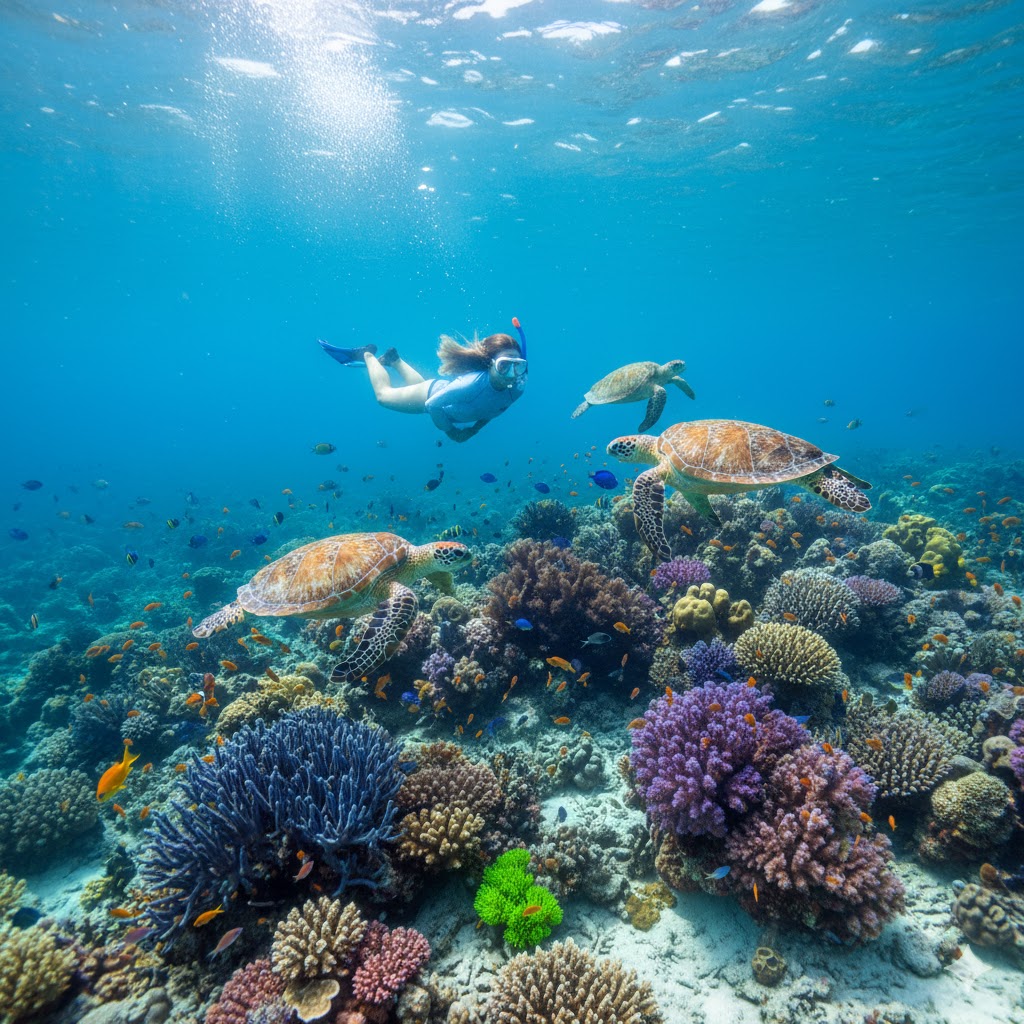
4. Micronesia & Vanuatu — Heritage Beyond Horizons
These remote islands are embracing ancestral navigation and digital nomad visas — blending ancient knowledge with modern sustainability.
Vanuatu’s “Volcano to Village” trail lets visitors hike active cones and stay in traditional bamboo huts, with proceeds funding education for local children.
“Our ancestors guided by stars — now we guide travelers by purpose,” says Ruben Kaloris, chief of a coastal village in Espiritu Santo.
Traveler Tip:
Best travel months: May–October (dry season). Bring reusable bottles and reef-safe sunscreen.

5. The Ethics of Tomorrow — What Comes After Exploration?
2026 marks the moment where travel transforms into planetary stewardship.
From Antarctica’s glacial silence to the jungles of Fiji, every step forward is also a commitment backward — to restore, respect, and rethink.
Emerging initiatives include:
- Carbon Offset Blockchain Passports — tracking emissions across trips.
- Ethical Tourism AI Systems — rating destinations on sustainability, not popularity.
- Regenerative Villages — blending community living and traveler education.
“The true luxury of 2026 isn’t private islands — it’s purpose,” says Elena Mora, founder of Ethical Voyager Alliance.
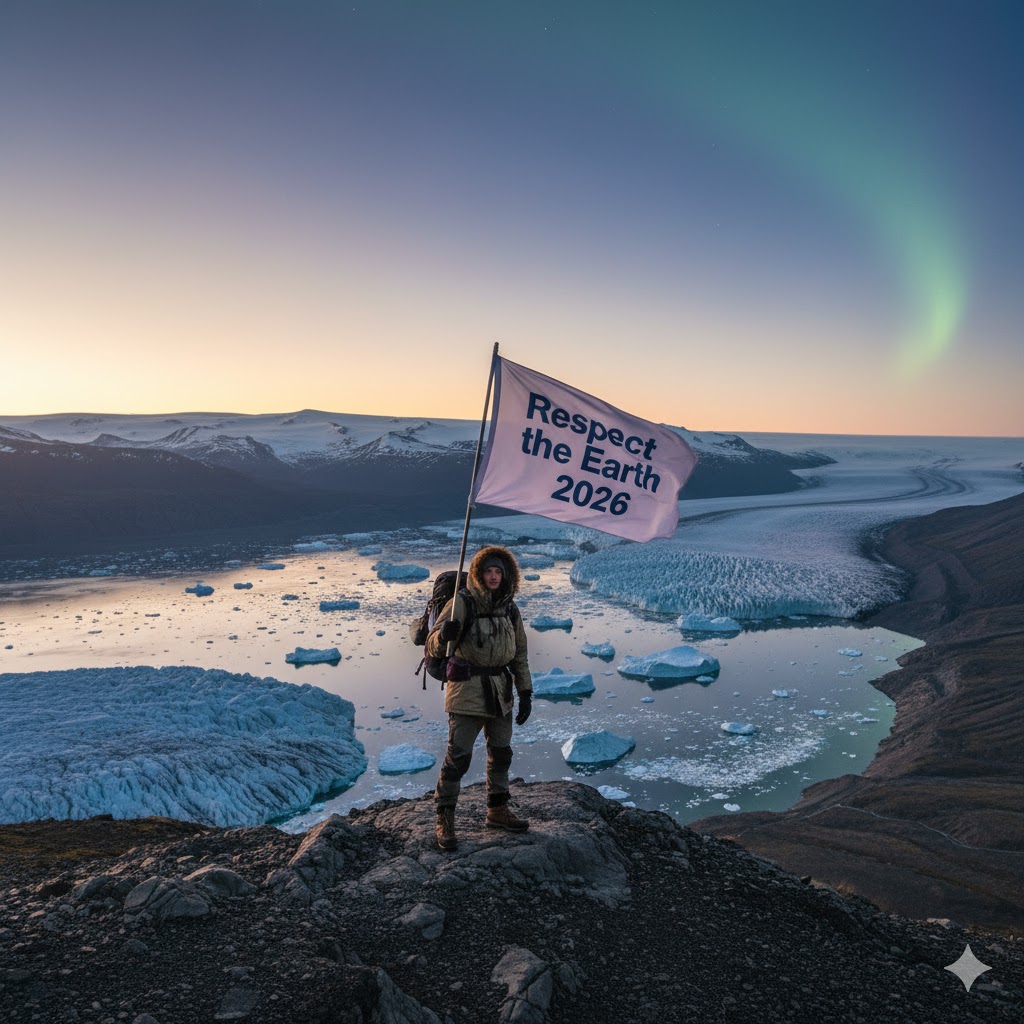
Traveler Conclusion — Rediscovering Wonder Without Wounds
As 2026 unfolds, travelers aren’t chasing selfies — they’re chasing symbiosis.
The final frontier isn’t outer space — it’s inner consciousness, reflected through how gently we walk the Earth.
From the poles to the Pacific, the future of travel is ethical, emotional, and essential.
The journey never ends — it simply evolves.
Read More
- Must See:
- Source:
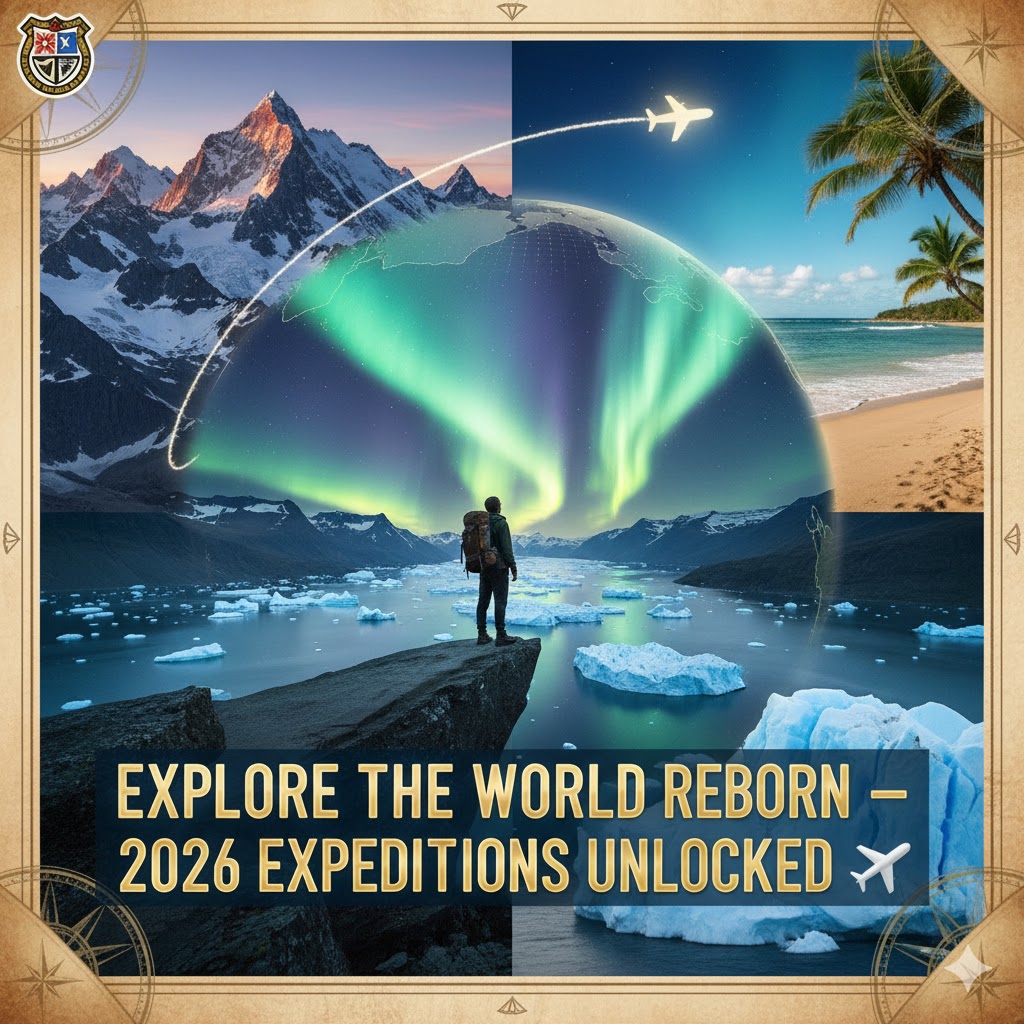




Pingback: Shocking Truth Snake Rain, Frog & Fish Rain: 3 Science of Animal Rain